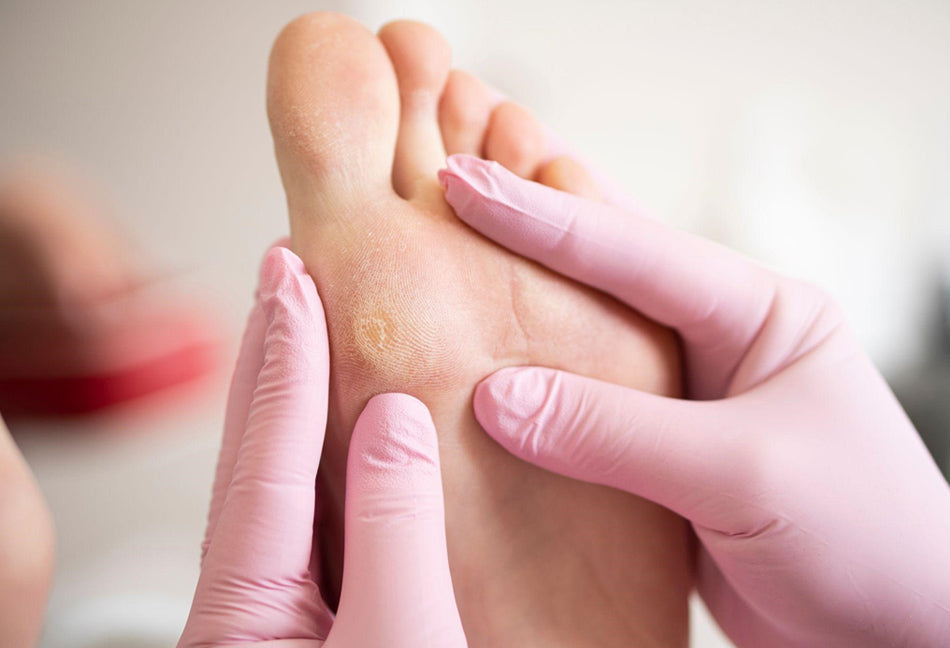Corns and calluses are common foot complaints, but it’s important that you know how to spot them when they occur. Knowing the difference between a blister and a corn, or a callus and a verruca can help to ensure you choose the right treatment to get back to your everyday activities sooner rather than later. So, what is a corn?
What is a corn on your foot?
Corns and calluses are areas of hardened skin that typically form as a result of increased pressure on that particular area. People who do a lot of hard manual labour, such as construction workers, often get calluses on their hands, as do those who play string instruments. It can be helpful to think of it as a sort of defensive layer that forms to protect softer skin – and it’s exactly the same on your feet as well.
Although the terms are often used interchangeably, corns and calluses are slightly different things. Corns are small areas of raised, thick, hardened skin. On the other hand, calluses tend to be larger areas of hardened skin that aren’t as raised from the surface of the skin. Both have similar causes.
Your likelihood of getting a corn or callus can depend in part on your day-to-day activities. If you lead a very sedentary lifestyle, you may be less likely to develop calluses on your feet than if you’re a marathon runner, for example. The more you use your feet and the more pressure they’re under, the more likely it is that you could develop a callus.
However, it isn’t a direct cause and effect relationship. Other factors can come into play, such as how comfortable your feet are in your shoes. If the soles of your shoes don’t provide enough cushioning, your feet may be under more pressure than they would be in something with a thicker sole. If this is the case, insoles may be an appropriate option to try and relieve your calluses. For example, it may be that only a small area of your foot is bearing a lot of pressure, in which case a pressure-relieving insole could be a simple fix to help your feet feel better quicker.
As well as the hard area of skin on the surface of your foot, corns also typically featured a hardened ‘root’ growing inwards. There is a commonly held misconception that removing this root in addition to the rest of the corn will prevent the condition from returning. Unfortunately, though, if nothing changes in relation to the pressure your feet are under, surgically removing the corn will only be a temporary fix until the hardened skin forms again. For this reason, pressure relief is one of the most effective ways to treat and prevent corns in the long term.
Are corns painful?
In some cases, corns and calluses can be painful and tender. The extent of this discomfort can depend on the location of the callus. For example, a lump of hardened skin on the top of your toe might only be painful when you wear certain shoes that rub against it. On the other hand, a callus on the sole of your foot is likely to be under pressure the whole time you’re on your feet, and can be more painful.
This, in turn, can have a big impact on how you go about your everyday life. If your feet hurt all the time, you’re likely to be reluctant to go for walks for leisure, preferring only to walk if you really need to. This can impact your health and fitness, as well as your psychological wellbeing. If you’re tempted to use a car or public transport more often because of this, then it can also have an environmental and financial impact.
As well as that, it’s only natural that being in pain and feeling unable to get about as easily as you would usually can lower your mood. This is especially true if you’re someone who usually does a lot of walking or running. Although a corn may only be a small area of hardened skin, it can have a big impact, which is why it’s a good idea to tackle the problem sooner rather than later.
Are corns contagious?
If you currently have a corn or callus, you might be worried about the potential of passing it on to others in the bathroom, at the beach or around the swimming pool. Fortunately, corns and calluses are caused solely by increased pressure or rubbing on a given area of the foot. They’re not caused by an infection, so they can’t be passed on. It’s still a good idea to always wear shoes of some description rather than going barefoot, as this helps to cushion your feet and avoid exacerbating your calluses.
However, if your corn or callus becomes infected, there is a possibility that you could pass on that infection to another person. An infected callus or corn is usually quite noticeable as the area may bleed or discharge pus. If this is the case, you should see a doctor or pharmacist for treatment for the infection, and keep the wound covered as much as possible.
- You should also seek medical attention if:
- You have heart problems or circulation issues
- You’re diabetic
- Your corns and calluses don’t improve after three weeks of at-home treatments
- Your pain is severe enough to prevent you from sleeping, going to the bathroom and dressing yourself as normal
In the vast majority of cases, corns and calluses are a simple foot condition that can be remedied with at-home treatments like pressure-relieving insoles. Remember to keep a good foot care routine, and you should be able to spot and deal with corns and calluses with ease.

